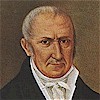|
 Alessandro
Volta Alessandro
Volta
principal papers
.
hardware
.
software
.
keywords
Voltaic
Pile
see also
related subjects
|
Achievement
Volta, Alessandro, Count, Italian physicist, known for his pioneering
work in electricity, invented the Electric Battery in 1800.
Biography
Volta was born in Como and educated in the public
schools there. In 1774 he became professor of physics at the Royal
School in Como, and in the following year he devised the electrophorus,
an instrument that produced charges of static electricity. In 1776-77
he applied himself to chemistry, studying atmospheric electricity
and devising experiments such as the ignition of gases by an electric
spark in a closed vessel. In 1779 he became professor of physics at
the University of Pavia, a chair he occupied for 25 years. By 1800
he had developed the so-called voltaic pile, a forerunner of the electric
battery, which produced a steady stream of electricity. In honor of
his work in the field of electricity, Napoleon made him a count in
1801. The electrical unit known as the volt was named in his honor.
In 1819 he finally retired to private life in his country house in
Camnago, where he died of cancer of the uterus in 1827.
Chronology
In 1800, he announced a new electrical device, the
Voltaic Pile, initially presented as an "artificial electric
organ", in controversy with the claimed autonomy of animal electricity.
This device was made of alternating disks of zinc and copper with
each pair separated by brine soaked cloth. Attaching a wire to either
end produces a continuous current of low intensity. This was the first
direct current battery. This put an end (for a time) to Galvani's
theory of animal electricity. It is interesting to note that Volta
described his battery as an electric organ and likened it to the electric
organ of the torpedo fish, which had columnar stacks of cells.
The importance of the invention and its applications, which came about
in a few months, seemed to prove the Como scientist right. His fame
has since conquered the world. But the idea of animal electricity
did not prove useless. Volta’s invention was to give rise to
electrochemistry, electromagnetism and the modern applications of
electricity. Galvani’s research was soon to develop into electrophysiology
and modern biology. The possibility of producing electric currents
was to change science and technology in the new century. As an experimental
physicist and inventor of instruments, Volta enjoyed unequaled success,
but nowadays one must remember also his notable theoretical contributions
(the product of intensive and extensive quantities, tension, capacity,
the law of bimetallic contact, atmospheric electricity) which, while
going against the Newtonian line, were to prove invaluable for the
development of the experimental sciences of the eighteenth century.
Honors and Awards
Volta received his greatest honor at the hands of
his fellow scientists. The unit of electromotive force- the driving
force that moves the electric current- is now called the "volt."
The energy of moving charged particles produced by modern atom-smashing
machines is measured in electron-volts. A billion electron-volts is
abbreviated "bev," and when we speak of the particular atom-smasher
called the bevatron, the "v" in the name stands for Volta.
Related Subjects
|
![]()